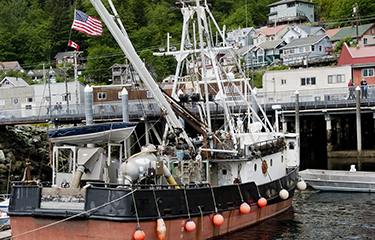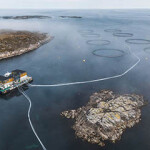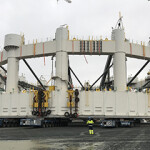Alaska’s seafood processors hit hard by COVID-19 costs

Overcoming serious doubts, Alaska’s salmon processors managed to squeak out a season this summer – but it came at a cost.
According to a McDowell Group report, processors spent as much as USD 50 million (EUR 42.4 million) on COVID-19 protocol compliance, which included moving workers into Alaska early for quarantine, putting them up in hotels for their quarantine period, flying them on chartered planes, food costs, and paying for significant coronavirus testing and personal protective equipment, as well as security to ensure closed campuses. In a few cases, companies had medical professionals embedded onsite in remote locations to ensure care to their employees (and to limit any potential spread of coronavirus that would have crippled the functionality of the facility).
“Our biggest challenge in 2020 was safely staffing our plants,” OBI Seafoods Public Affairs Manager Julianne Curry told Alaska Public Media. “It was a huge lift to get all employees tested, transported, quarantined, and fully-integrated into each of our plants all while observing a closed campus and all COVID-related protocols and doing it all with very little time to plan and prepare for the summer salmon season.”
Pacific Seafood Processors Association Vice President of Alaska Operations Nicole Kimball said several of her members – a group that includes Trident, Peter Pan, and Alaska General Seafoods – spent at least USD 10 million (EUR 8.5 million) each on COVID-19-related costs.
“As we learned new information about the virus, we had to change protocols – so constantly evolving situation, protocols, information – in order to stay most up-to-date on how it’s likely transmitted, the scale of asymptomatic cases, how long someone will test positive even after they’re no longer contagious,” Kimball said. “All those things were constantly kind of in flux.”
While there were 13 percent fewer employees needed to fill spots in Alaskan processing facilities this summer due to social distancing requirements being enforced on processing lines, the total was still sizeable. Testifying in front of the U.S. Senate Commerce Committee on 29 July, Silver Bay Seafoods CEO Cora Campbell estimated this year’s seasonal employee count at 18,000.
“These are significant and unique costs due directly to COVID-19, but they are necessary in order to operate, and protect the food supply chain, the workforce, and Alaska communities,” Campbell said in her testimony. “The industry is taking on these costs out of pocket at the same time we are facing severe disruption in key markets and multiple pre-COVID cost burdens.”
If the first goal of the season was to minimize the spread of the coronavirus, Alaska’s seafood processors largely succeeded. While there were several outbreaks among seasonal employees – OBI Seafoods, Copper River Seafoods, American Seafoods, Alaska Glacier Seafoods, and Kwik’Pak were among the companies that experienced cases, sometimes dozens – generally, the precautions taken by the industry paid off as the disease remained confined to the workforce and didn’t spread into local communities.
But some processors may be questioning whether all the trouble and expense was worth it, as lower prices combined with a distressed global economy and supply chain issues to drive down profits.
While the McDowell Group report found Alaska’s harvest volume was not significantly impacted by the pandemic, smaller salmon runs and lower prices delivered a double-whammy to processors already reeling from the added expenses the coronavirus added to their bottom lines. Add in disruptions to foreign trade due to global lockdowns and fewer international flights, and lower demand in the domestic market for fresh fish, and the result was sockeye prices falling by around 50 percent this year in Bristol Bay. Halibut and Pacific cod harvest values also declined, the McDowell report found, while pollock prices remained stable. And companies were unable to perform as much value addition as usual, dealing another blow to their product mix and their bottom lines.
One company that got lucky this season was Silver Bay Seafoods, as a long-term commitment to automation and maximizing plant efficiency likely saved the company millions of dollars this year in expenses on COVID-19 compliance.
“Silver Bay greatly leveraged new potential of technology to achieve higher levels of automation, reducing labor costs by 50 percent versus competitors [precoronavirus],” Larsen Mettler, who served as Silver Bay Seafoods’ chief financial officer from 2016 until August 2020, told SeafoodSource. “This enabled us to create new product forms and be much faster than our competitors.”
Some of the best moves made by Silver Bay, which Mettler said helped build the company into a powerhouse in the hypercompetitive and oversaturated Alaska seafood processing scene, included the introduction of high-quality tunnel freezing technology and a shift away from heavy reliance on canning. Higher-efficiency cutting machines also helped deliver significantly greater recovery of product, Mettler said.
“Our competitors were using 75 to 80 percent of their fish, while Silver Bay was using 90 to 95 percent,” he said. “That helped us find and create new markets, both for traditional product, but even more so for products like oil and feed.”
That preemptive investment in technology, accomplished over the past four years, positioned Silver Bay well for the extreme lurches the seafood market has undergone since the coronavirus reached pandemic-level.
“The technology we introduced brought the industry up as a whole, and did force competitors to step up and at least pay fisherman more on margins,” Mettler said. “But it came from looking at areas where technology could be applied and specifically by looking at our big costs and pain points, taking a hard look at how we could improve.”
While COVID-19 brought some pain to all of Alaska’s seafood companies, it also provided one major upside, Mettler noted, as a rush on retail products allowed companies to run through a backlog of inventory, including shelf-stable products like cans and pouches and frozen portions, which were “completely depleted.”
“That demand throughout the retail market, particularly at front end of COVID, meant that inventory that was there got swept out,” he said. “That was important as a lot of products had been backed up for the last couple of years. And it was particularly important for companies going into fresh and foodservice – it’s no secret that companies that were delivering to those markets had to find alternatives.”
Companies that were able to quickly pivot to retail and to online sales did best, Mettler said.
“I don’t think that’s just a coronavirus thing,” he added. “I think we’ll continue to see that happen.”
The competitive advantaged gleaned through innovation likely extends to COVID-19 safety protocols. While most companies improvised and made do this summer, if the coronavirus crisis extends into next year, firms best able to contain their COVID-related costs will be best-positioned to succeed.
Curry said OBI Seafoods is already bracing for additional COVID-19 state and federal safety requirements and more comprehensive best practices in 2021. She told Alaska Public Media the current mandate issued by the state to the seafood industry is 10 pages long, but a as-yet-unpublished updated draft is 29 pages long.
“It’s safe to say that the processing sector will be seeing an increase in protocols in 2021 and that COVID is far from over for our industry. We anticipate that our COVID-related costs will be just as high, if not higher than last year,” she said.
Photo courtesy of dani3315/Shutterstock






Share